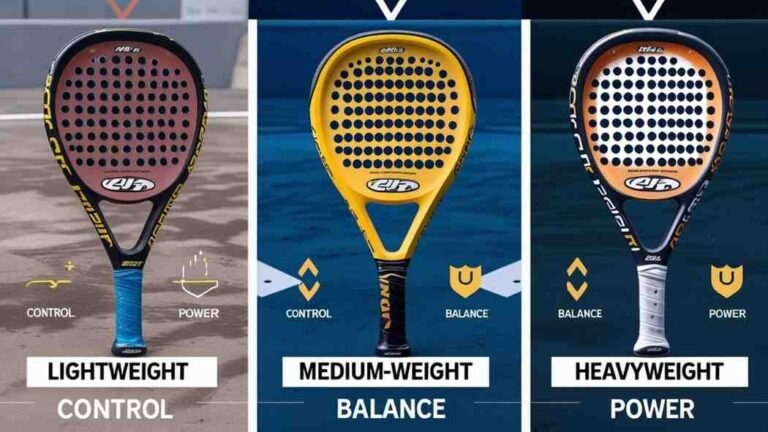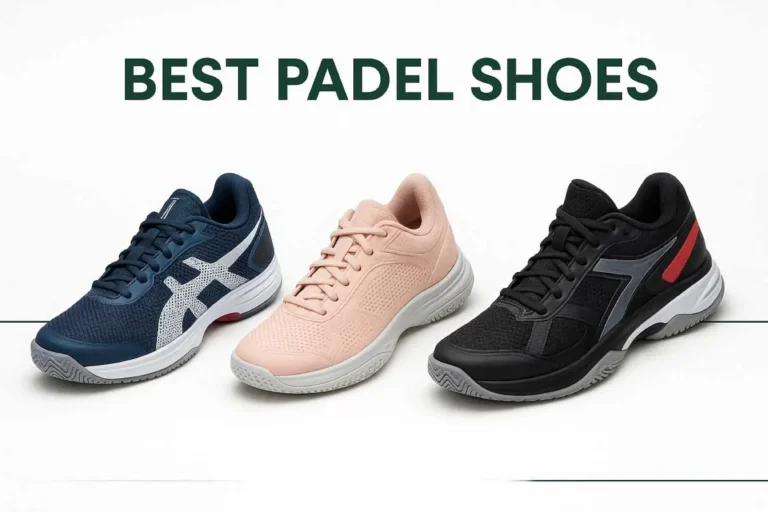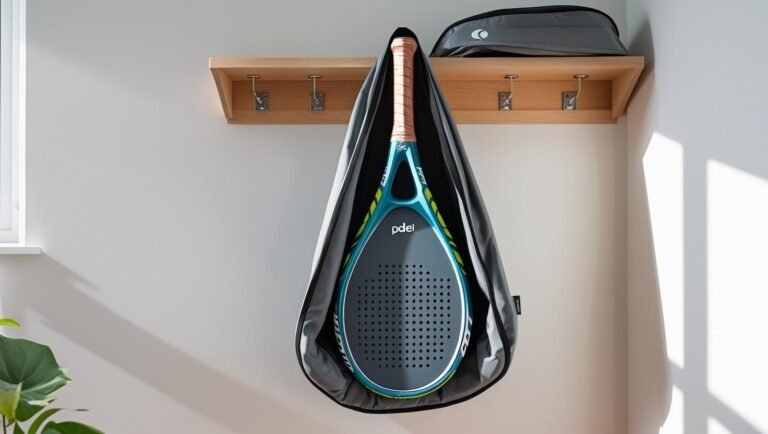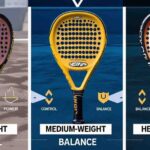Want a shortcut? Take a quiz and find your perfect Padel Racket in 30 secs.
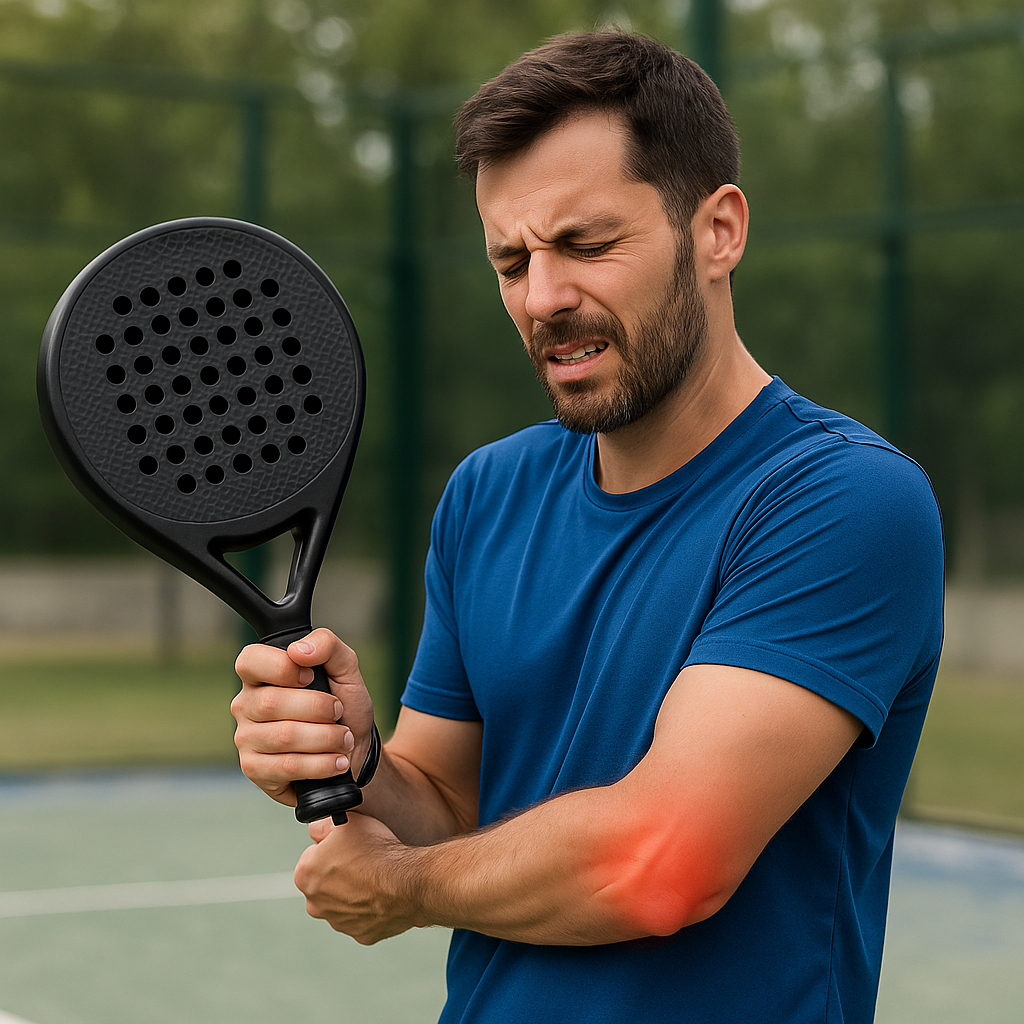
Why Do Some Padel Rackets Cause Elbow Pain & How to Fix It?
Playing padel can be addictive — it’s fast, fun, and social. But if you’re starting to feel a nagging ache in your arm after a few matches, it might be more than just fatigue. Often, padel rackets cause elbow pain due to poor design choices or an imbalance in weight and balance.
The shape, materials, and stiffness of your racket can put extra pressure on your elbow, especially during repeated shots. This issue affects both new and experienced players, so you’re not alone if you’re feeling discomfort.
The good news? You don’t have to quit the game you love. In this article, you’ll find out why padel rackets cause elbow pain, how to spot the warning signs early, and what practical steps you can take to fix the problem and keep playing pain-free.
Why Padel Rackets Cause Elbow Pain?
Elbow pain in the padel usually starts small — a bit of soreness after playing. But over time, it can grow into a nagging injury that stops you from enjoying the game. One of the most common reasons padel rackets cause elbow pain is a condition known as padel elbow, similar to tennis elbow. It happens when the muscles and tendons in your arm are overused or strained, often due to repeated impact and poor equipment choice.
1. Using the Wrong Racket
Padel rackets that are too heavy, stiff, or head-heavy often cause elbow pain by increasing vibration and stress on your arm.
Choosing the wrong padel racket is one of the top reasons players experience elbow discomfort. A heavy frame makes each shot harder on your joints, especially if you lack strong forearm muscles. If the racket has a hard surface or stiff frame, it won’t absorb the impact from the ball, and your elbow ends up taking the shock. Head-heavy rackets add more weight to your swing, forcing your muscles to overcompensate.
Over time, this repetitive stress leads to inflammation and soreness, particularly around the elbow joint. For most casual or amateur players, a racket that weighs between 340–365 g with a balanced design is easier on the body. Newer rackets with shock-absorbing cores or vibration-dampening technologies are much more elbow-friendly. The takeaway? The right racket won’t just improve your performance — it will protect your arm from chronic pain and injury.
2. Poor Technique
Incorrect grip, tight muscles, and poor form can make even the best padel racket cause elbow pain.
Many players assume their gear is the issue, but technique plays a significant role in injury risk. One of the most common mistakes is gripping the racket too tightly. This keeps the forearm muscles tense and reduces your arm’s ability to absorb impact. Combine that with a stiff wrist or weak follow-through, and the tendons around your elbow are constantly under pressure. Over time, these habits lead to what’s often called “padel elbow” — a painful condition similar to tennis elbow.
Even if your racket is designed for comfort, poor technique can still cause elbow pain with your padel racket. To fix this, start by using a continental grip, keep your hold relaxed but steady, and focus on generating power from your body — mainly your shoulder and torso — instead of overusing your arm. Minor adjustments in form can prevent long-term issues. Watching pro matches, training with a coach, or filming your swing for review can help you spot and correct these mistakes early.
3. Overplaying Without Rest
Skipping recovery days is a fast track to elbow pain — even if your Padel racket doesn’t cause elbow pain on its own.
The excitement of playing padel — especially when you’re hooked — often leads to overuse injuries. Many players dive into back-to-back matches or practice daily without giving their arms time to recover. Even if your technique is solid and your padel racket doesn’t cause elbow pain directly, this non-stop play can still lead to muscle fatigue and tendon strain.
Your arm needs time to repair microtears in muscles and tendons after intense use. Ignoring early signs, such as stiffness or minor soreness, can lead to a long-term injury. That’s why it’s essential to schedule one to two rest days each week. Include forearm workouts and light cross-training activities, such as stretching or swimming. Also, use ice therapy or compression sleeves after play to reduce inflammation.
Taking time to rest doesn’t mean you’re slacking — it’s one of the most innovative ways to make sure your padel racket doesn’t cause elbow pain in the long run. Protect your arm now, and you’ll enjoy the game for years to come.
4. Bad Vibration Control
Rackets with poor vibration dampening are one of the top reasons a padel racket can cause elbow pain.
Each time you strike the ball, vibrations travel from the racket to your arm. If your racket doesn’t absorb those shocks well, your elbow ends up taking the hit. Over time, this constant impact puts stress on the tendons and can lead to injuries like lateral epicondylitis, commonly known as tennis elbow. Older models or less expensive rackets often lack essential features, such as EVA Soft Foam or anti-vibration technology in the frame, which can make them more likely to cause elbow pain.
You’ll notice the difference: each hit feels harder, and your elbow may feel sore after play. If your padel racket causes elbow pain due to vibration, the solution is simple — upgrade to a racket with a vibration-dampening core. You can also use elbow-friendly overgrips or anti-vibration dampers to reduce the shock. Look for rackets marketed with “comfort” or “control” features, as these are designed to be easier on joints.
Focusing on vibration control not only improves your comfort but also helps you avoid long-term elbow problems that take the fun out of the game.
How to Avoid Padel Rackets That Cause Elbow Pain
Choosing the right padel racket can make a big difference for your elbow. The goal is to reduce the shock and stress on your arm. Here’s what to look for when picking a racket that’s easy on your elbow:
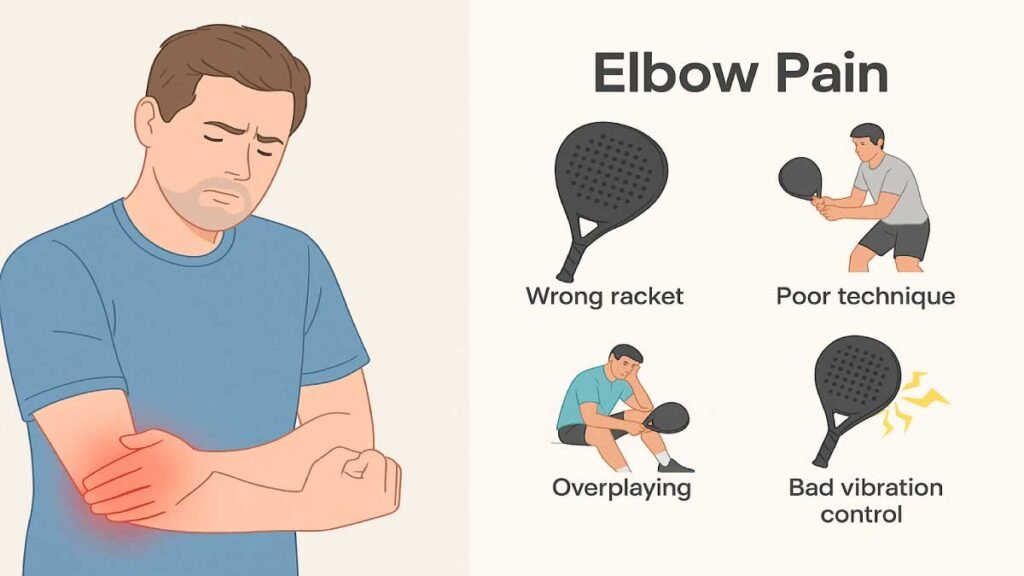
1. Soft Core Material
Soft-core rackets reduce vibration and protect your elbow.
If padel rackets cause elbow pain, the core is likely to be the culprit. Rackets with soft EVA or foam cores absorb more shock when you hit the ball. This stops the vibrations from travelling up your arm, easing the strain on your elbow tendons and muscles.
Hard-core racket sports send that force directly to your joints, increasing your risk of overuse injuries. Choosing a soft-core design is one of the simplest ways to prevent elbow injury in padel, especially if you play often or already have discomfort. These rackets are also more forgiving on mishits, which further protects your arm.
2. Even Balance
Even balance spreads weight evenly, reducing elbow strain.
Many padel rackets cause elbow pain because they are head-heavy, meaning more weight sits at the top of the racket. This creates more torque and pressure on your wrist and elbow during each swing. In contrast, rackets with even or low balance distribute weight across the frame.
This balance gives you more control and limits the load placed on your arm. If you’re trying to prevent elbow injury in padel, switching to a balanced racket is a smart step. It helps you swing more naturally, reduces fatigue, and keeps your strokes fluid without compromising power.
3. Lightweight Design
Lighter rackets put less pressure on your arm and elbow.
A common reason padel rackets cause elbow pain is their weight. Rackets that weigh more than 370g can overload your arm, especially during long rallies or fast-paced games. Choosing a lightweight padel racket (between 340g and 365g) makes each shot smoother and lowers stress on the joints.
For many players, especially beginners or those with smaller builds, this small weight change makes a big difference. A lighter racket helps maintain form, improves swing control, and allows for faster reactions — all while reducing the chance of elbow problems. It’s a key way to prevent elbow injury in padel without changing your style.
4. Anti-Vibration Technology
Anti-vibration tech reduces shock and protects your elbow.
Some padel rackets cause elbow pain because they don’t filter out the shock from each hit. With no damping mechanism, that energy travels straight to your elbow. Modern rackets now feature anti-vibration systems built into the frame or handle.
These designs work like shock absorbers, lessening the impact and preventing tendon overload. For players recovering from injury or trying to avoid injury in padel, rackets with this technology offer serious protection. It’s not just a gimmick — you’ll notice less post-game soreness and more comfort during intense play. Look for brands that highlight vibration control in their specs.
5. Comfortable Grip
A good grip eases tension in your hand and elbow.
Even if a racket has excellent balance and a soft core, a bad grip can still cause problems. If it’s too small or worn down, you’ll grip it more tightly than needed. This leads to arm stiffness and is a significant reason why padel rackets can cause elbow pain.
A thicker, cushioned grip spreads the pressure and allows you to hold the racket more loosely, precisely what your elbow needs. Replacing or upgrading your grip regularly also enhances comfort and reduces sweat, which in turn helps with control. It’s a minor fix, but essential if you want to prevent elbow injury in padel.
Best Padel Rackets That Reduce Elbow Pain
Not all padel rackets are made the same. Some are built for power, but others are designed to prevent the common issue of elbow pain caused by padel rackets. If your arm needs relief, go for models designed to reduce shock and lighten the load — they protect your elbow while still giving you excellent control on the court.
1. NOX ML10 Pro Cup
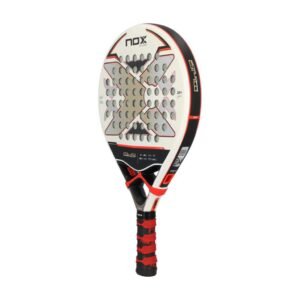
Why it’s suitable for your elbow:
- Soft EVA core for excellent shock absorption
- Even balance helps reduce pressure on joints
- Lightweight and easy to handle
- Built-in anti-vibration system
2. Adidas Adipower Light 3.2

Why it’s good for your elbow:
- Very lightweight—easy on joints
- EVA Soft Performance core
- Structural reinforcement for stable play
- Designed for control-first players
Check out the Best Padel Rackets which fit your Elbow.
Additional Tips to Prevent Elbow Pain in Padel
Switching to a softer racket is a good start, but that’s not the full fix. To fully protect your elbow, it’s important to focus on technique, body care, and training habits.
1. Warm Up the Right Way
Don’t skip the warm-up. Start with shoulder rolls, forearm stretches, and a few minutes of light cardio. This helps loosen up your arm muscles and can lower the risk of elbow pain caused by sudden strain from padel rackets.
2. Strengthen Your Forearm & Shoulder Muscles
Weak arms absorb less shock. Strength training is important if padel rackets cause elbow pain during matches. Try:
- Wrist curls (using light weights or resistance bands)
- Reverse curls
- Isometric holds
Do them 2–3 times a week. Stronger muscles absorb more shock and support your joints.
3. Fix Your Grip Technique
A tight grip can exacerbate elbow pain caused by padel rackets. Instead, try:
- Using a continental grip
- Keeping your grip relaxed but firm
- Changing over grips regularly for better hold and comfort
4. Use Elbow Support or Compression Sleeves
Compression sleeves or elbow straps give extra support when padel rackets cause elbow pain during longer sessions. They reduce pressure without limiting movement.
5. Take Breaks and Rest
One big reason padel rackets cause elbow pain is overuse. If your arm starts to ache, stop playing and rest for a day or two. Recovery helps prevent long-term injury.
Conclusion
Choosing the wrong padel racket can do more than hurt your game — it can hurt your arm. Many players don’t realise that certain padel rackets can cause elbow pain due to factors such as excessive weight, rigid materials, and poor shock absorption. Every hit sends stress into your joints.
The fix? It starts with the right gear.
Switch to a lightweight, softer racket that absorbs impact better. Focus on improving your grip, and technique, and managing how often you play. Add in smart habits like forearm strengthening, elbow sleeves, and proper warm-ups, and you’ll be back on court — pain-free and confident.
Ready for More? You’ll Love This Insight
- How to Choose the Right Padel Racket
- Best Padel Rackets for Men
- Best Padel Rackets for Women
- Best Budget Padel Rackets
- Best Beginner Padel Rackets
- How to Replace the Grip on a Padel Racket
- Can You Use a Tennis Racket for Padel?
- How to Grip a Padel Racket Correctly
- Best Padel Racket Accessories
- Adidas vs Wilson: Which Padel Racket Brand is Better?
- The Top Most Durable Padel Rackets
- The Evolution of Padel Rackets Over the Years
FAQs
Elbow pain in padel usually comes from using a heavy or stiff racket on hard surfaces. These types of padel rackets cause elbow pain because they generate more vibration with each hit, putting extra pressure on your elbow over time.
Yes. A grip that’s too small or too big makes your hand work harder to hold the racket. That adds strain to your forearm and elbow, increasing your risk of pain or injury.
Look for a lightweight padel racket with a soft surface and low balance. These reduce vibration and are easier on your arm. Choose a model designed for comfort and control, not just power.
Stop playing for a few days. Use ice packs, compression sleeves, and take anti-inflammatory medicine if needed. Try light forearm exercises to gradually build strength. When you return, switch to a softer racket and adjust your technique.
Yes. Many beginners start with the wrong gear, and that’s where problems begin. Some padel rackets cause elbow pain when paired with poor form, leading to strain early on. Choosing an arm-friendly racket and learning proper technique from day one can make all the difference.
